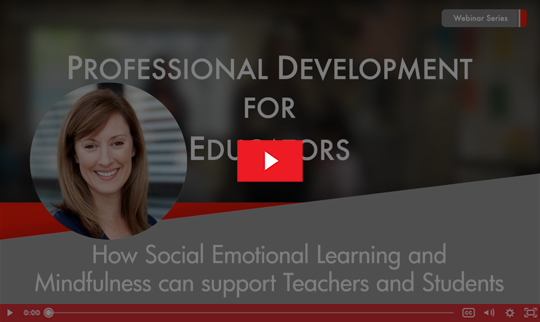How to Use Mental Health Check-Ins to Address Students’ Social-Emotional Needs
Simple and consistent mental health check-ins are small efforts that can support social-emotional learning (SEL) in the classroom, build rapport among teachers and students, and help adults assess and better address the emotional needs of students at school. This article provides strategies for successful mental health check-ins and resources to support students’ mental health and mindfulness at school.
The Purpose of Mental Health Check-Ins
Students often have many things going on in their lives that are hidden from view; they may be grappling with past traumatic experiences, or they may be currently dealing with trauma in their home or neighborhood, or struggling with peers, in academics, or with their dreams and ambitions. Our students are emerging individuals with their own unique struggles. Someone in the school might be aware of individual student needs, but may be unable to explain the struggles to other colleagues due to confidentiality. Sometimes students choose to process their emotions close to the vest.
Regardless of whether or not students discuss their personal trials, we adults need to interact with students without assuming we know their motivations. There might be factors we can’t see lurking behind student behaviors. In schools, our professional purpose as counselors and educators is to foster our students’ confidence and curiosity. No matter our function, we are triaging the social and emotional needs of our students while they are with us in our scholastic bubble.
Mental health check-ins tell our students a lot about how we value them and that we want to develop relationships. Checking in with students does not have to be an intense, deep conversation about mental health. Many times, quick and intentional interactions with students help them develop a larger belief that there are people who recognize their existence and care about their well-being. These mental health check-ins are based in social-emotional learning.
The Keys to Successful Check-Ins
Taking time to lay the groundwork for student relationships will lead to more meaningful interactions. The three keys to successful mental health check-ins are consistency, simplicity, and persistence.
Consistency
The first key to student check-ins is consistency. In middle school, it takes about three meetings with a student to get them to trust your authenticity. Here is the pattern of response I experience with almost all students as I am establishing a relationship with them
- awkward and quiet with little eye contact
- question responses to every question asked by adult
- small bits of personal information offered as if testing
- excitement to communicate, with classic middle school nonchalance
- hook-line-and-sinker buddies with open conversation
Mind you, these interactions are typically around five minutes each—not long at all! Once you put in the work for the first couple of meetings, each subsequent Hello, how was your weekend? How is your mom doing? Don’t forget homework! is more impactful because the student believes you really want to know the answers. Responses from the students are also much more meaningful, and they grow more and more honest and emotionally based as time goes on. How are you feeling today? might then elicit a real and clear emotional check-in so that you can better assess what the student needs to have a successful day.
Simplicity
The second key to successful mental health check-ins is simplicity. Mental health checks-ins do not need to be time-consuming or require psychological or clinical follow-through. I have so many teachers that have amazing doorway techniques; they make little connections with every student as kids walk into their classroom. They make eye contact, some of them shake hands, and others say each name with a genuine salutation. These teachers will without a doubt be more likely to then email me when their students have settled into an assignment and let me know who could use further assistance.
Persistence
Even when a student shoos you away, keep at it! When you show students that you truly care about how they are doing, instead of asking on a whim or as part of the job of an adult, they will feel safer about actually opening up to you. This type of deeper connection gives you a much better read on how the student is truly handling their day, week, or year.

Ways to Incorporate Mental Health Check-Ins
There are simple ways to incorporate mental health check-ins that promote social-emotional wellbeing. Use these simple strategies consistently in class to assess students’ needs.
Wellness-Centered Entry and Exit Tickets
One of the easiest ways for teachers to incorporate mental health check-ins with their students is to rethink the way they use their entry and exit tickets. Exit tickets are classroom tools where students answer a couple of questions or provide a short answer before concluding class. Entry and exit tickets can be used together for data collection on student understanding, and they are typically quick assessments.
Why not make them wellness centered? By getting a check on mood (maybe a sad/happy/indifferent scale for students to choose from) when students come into and leave the room, teachers can see what they may be combatting during instruction, as well as collect accountability data about the classroom environment’s impact on student feelings.
Quick check-in questions can include asking students what they need, how their evenings went, how frustrated they were with their homework, whether they have thoughts about their goals, where their anxiety over an upcoming test is settling in their body, and so on. The possibilities are endless. To use this strategy, just be sure to check in on the emotions instead of the content.
Using entry and exit tickets for mental health check-ins will also give teachers an idea of what students need. Are more than half the students anxious about a test or sad about a current event? With the data gathered during check-ins, a teacher would know what kinds of resources could benefit students, such as a specialist (maybe a school counselor or writing specialist) or help with organization or a breathing exercise.
In-Class Wellness Check-ins
There are many ways that mental health check-ins can be implemented throughout class, whether individually or in groups.
Individual Check-Ins
Individual mental health check-ins emphasize privacy and confidentiality with minute meetings or doorway greetings. For example, take the last five to ten minutes of class to give students an exit ticket and ask that they bring you their ticket individually to turn it in so you can discuss. You can train patience by telling them to come up one at a time!
Whole-Class Check-Ins
Whole-class mental health check-ins emphasize general feelings and events all students will experience. Utilize digital surveys, hand raising, and reflection charts that can mark either singular periods of time or continuous shifting. For example, give each student a two-sided card and instruct the students to turn the card over when they become frustrated during class. You can train self-regulation by asking that students close their eyes and take a deep breath until you can get to them to assist.
Peer Check-Ins
Peer mental health check-ins emphasize community building and empathy building by creating pairs or small groups in which you give students sentence starters with discussion time. For example, in groups of three, tell students to take turns identifying their favorite and least favorite memory from the weekend. You can train leadership by telling the students to take turns being the interviewer to help the other two students problem-solve their least favorite memory.
Mental health check-ins can be quick and simple, but used consistently they can become powerful tools to see what students need to thrive in our classrooms. These resources and strategies for mental health check-ins and mindfulness practices can support both teachers and students in addressing students’ social-emotional needs in order to be successful.
How Social Emotional Learning and Mindfulness Can Support Teachers and Students
When social emotional learning (SEL) and mindfulness are taught and learned together they have the power to transform individuals, classrooms, and communities. This dynamic on-demand webinar will provide participants with an overview of CASEL’s five core competencies and their connection to mindfulness.
Author Bio:
View All AuthorsStephanie Filio, M.Ed
Stephanie Filio is a middle school counselor in Virginia Beach. She received her undergraduate degree in interdisciplinary studies from the University of Virginia and her M.Ed. in counseling from Old Dominion University. In a discussion with one of her UVA professors about her desire to stay in school forever, her mentor wisely responded, “If you want to be a lifelong learner, go into education,” and so she found her place. Prior to her six years as a school counselor, Stephanie worked in...
Join the Free Spirit Publishing Blog Community
Subscribe by sharing your email address and we will share new posts, helpful resources and special offers on the issues and topics that matter to you and the children and teens you support.


